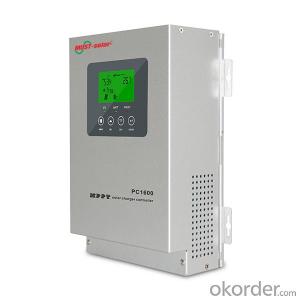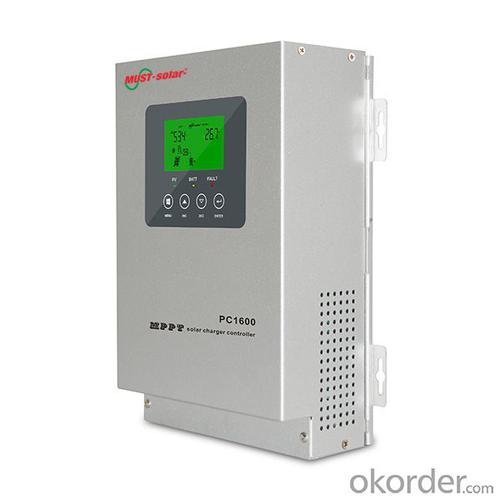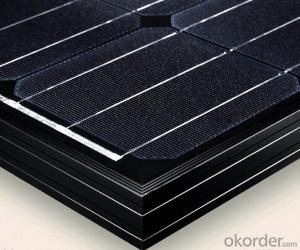Mppt Solar Charge Controller High Efficiency PC1600F SeriesMade in China
- Loading Port:
- China main port
- Payment Terms:
- TT OR LC
- Min Order Qty:
- 100 pc
- Supply Capability:
- 10000 pc/month
OKorder Service Pledge
OKorder Financial Service
You Might Also Like
Features:
·45A/60A MPPT solar charge controller
·12V/24V/36V/48V auto work
·PV Output :145v Max
·Several seconds tracking speed
·High Tracking efficiency of 99%
·Multiphase synchronous rectification technology
·Peak conversion efficiency of 98%
·DSP processors architecture ensures high speed and performance
·Multifunction LCD displays system data and status
·Four stages charging optimizes battery performance
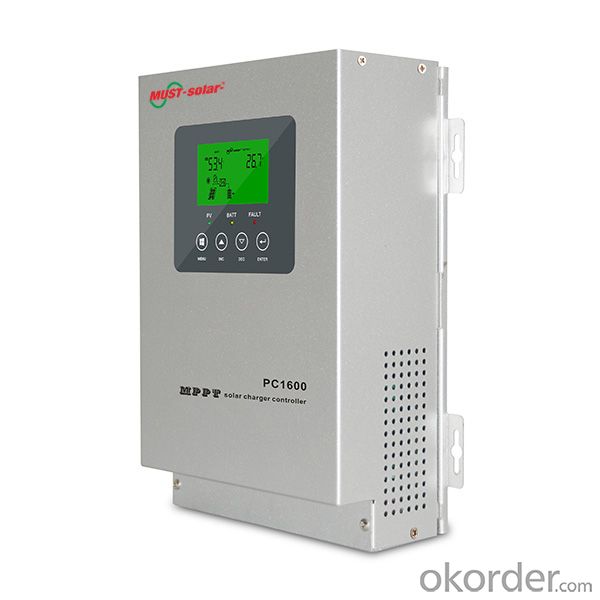
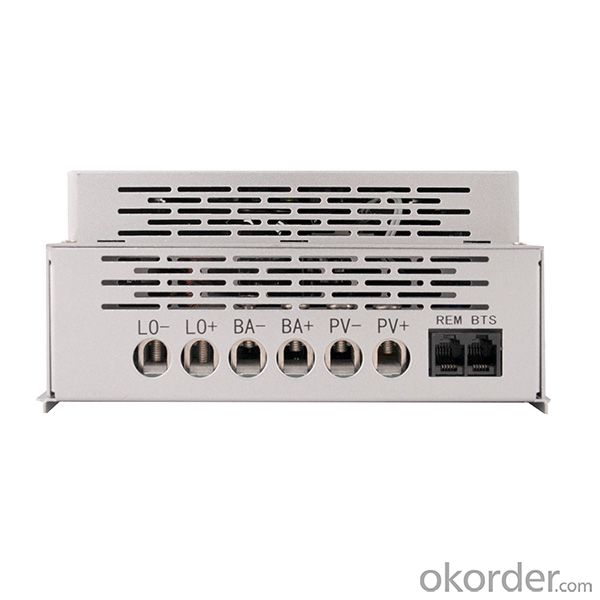
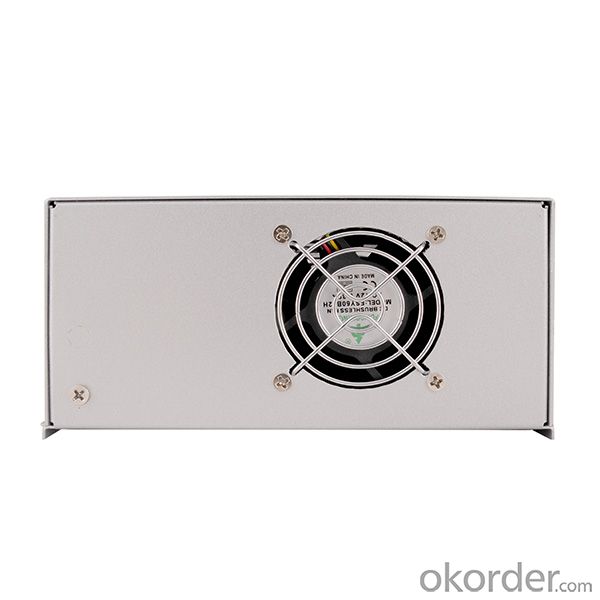
| Model | PC16-4515F | PC16-6015F | |
| Battery System Voltage | 12V/24V/36V/48 VDC (adjustable) | ||
| Charge Input | |||
| PV Open Circuit Voltage | Operational max = 145VDC temperature corrected VOC | ||
| Max PV Input Power(12V) | 600W | 800W | |
| Max PV Input Power(24V) | 1200W | 1600W | |
| Max PV Input Power(36V) | 1800W | 2400W | |
| Max PV Input Power(48V) | 2400W | 3200W | |
| Battery Voltage | |||
| Nominal Voltage | 12VDC/24VDC/36VDC/48VDC | ||
| Absorption Voltage | 13.5VDC/27.0VDC/40.5VDC/54.0VDC | ||
| Refloat Voltage | 13.7VDC/27.4 VDC/41.1VDC/54.8VDC | ||
| Float Voltage | 14.3VDC/28.6 VDC/42.9VDC/57.2VDC | ||
| Low Voltage Protection Point | 10.5VDC/21.0 VDC/31.5VDC/42.0VDC | ||
| DC Output | |||
| Output Voltage | 11.0~14.3VDC/22.0~28.6VDC/33.0~42.9VDC/44~57.2VDC | ||
| Max Charging Current | 45A amps continuous @ 40°C ambient | 60 amps continuous @ 40°C ambient | |
| Warning for low voltage | 11.5VDC/23.0 VDC/34.5VDC/46.0VDC | ||
| Cutoff for low voltage | 10.5VDC/21.0 VDC/31.5VDC/42.0VDC | ||
| Low voltage recovery | 11.5VDC/23.0VDC/34.5VDC/46.0VDC | ||
| Display | |||
| LED indication | Systematic operation, LV indication, LV protection, over charge protection, loads protection, short circuit protection | ||
| LCD display | Charge voltage, charge current, voltage of battery, capacity of battery, output current | ||
| Alarm | PV array short circuit protection, PV reverser polarity protection | ||
| Battery reverse polarity protection, Over charging protection | |||
| Output short circuit protection | |||
| Low voltage protection for storage battery | |||
| General specification | |||
| Environmental Rating | Indoor | ||
| Charge mode | MPPT, PWM, constant current—constant voltage, function of automatic protection for storage battery | ||
| Radiating mode | Fan cooling | ||
| Working mode | Four stage: Absorption CC, Absorption CV, Float CC, Float CV. | ||
| Peak Conversion efficiency | 98% | ||
| Environment | |||
| Environmental temperature | -25°C ~55°C | ||
| Ambient humidity | 0--90%,No condensation | ||
| Altitude | ≤3000m | ||
| Dimension | |||
| W*H* D(mm)/G.W(kg) | 167.6*257.1*82.9mm/3kg | 390*365*364mm(5pcs/carton) | |
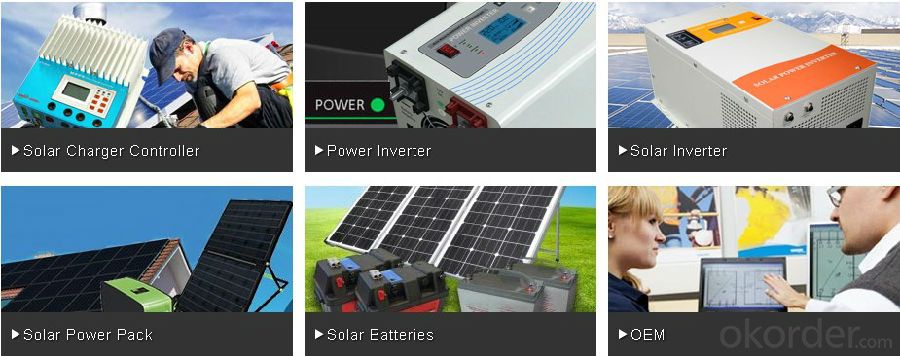
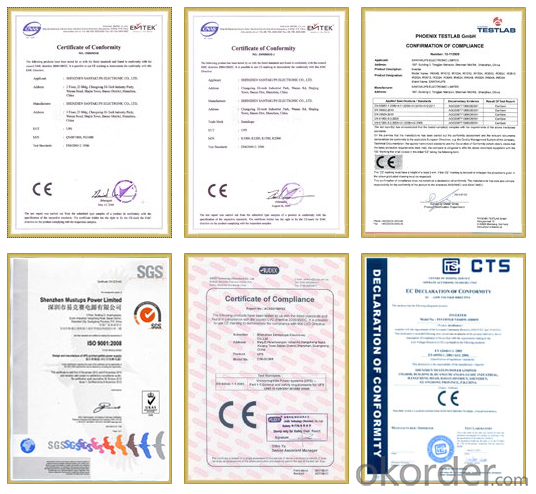

Warrenty
provides a 1~3 year limited warranty (“Warranty”) against defects in materials and workmanship for its Uninterruptible power supply, Power inverter/chargers, Solar charge controllers, Battery Products (“Product”).
The term of this Warranty begins on the Product(s) initial purchase date, or the date of receipt of the Product(s) by the end user, whichever is later. This must be indicated on the invoice, bill of sale, and/or warranty registration card submitted to MUST-Solar. This Warranty applies to the original MUST-Solar Product purchaser, and is transferable only if the Product remains installed in the original use location.
FAQ
1. How do I decide which system is right for me ?
For protection from long outages, include a generator or solar panels in your Must solar system. Shorter outages can be handled by a battery-only system.
2. Where my system will be installed ?
Must solar systems are usually wall-mounted near a home's main electrical (circuit breaker) panel.
3. How do I install my system ?
A must solar backup inverter is connected to a home electric system , we will supply detailed installation manual and videos for our customers .
- Q: Can a solar inverter be used with a solar-powered air purification system?
- Yes, a solar inverter can be used with a solar-powered air purification system. A solar inverter is responsible for converting the direct current (DC) generated by a solar panel into usable alternating current (AC) that can power electrical appliances. In the case of a solar-powered air purification system, the solar inverter can convert the DC electricity produced by the solar panels into AC power needed to operate the air purification system, allowing it to function efficiently with solar energy.
- Q: Can a solar inverter be used with battery storage?
- Yes, a solar inverter can be used with battery storage. In fact, it is commonly used in solar energy systems to convert the direct current (DC) power generated by solar panels into alternating current (AC) power that can be used by household appliances or stored in batteries for later use. The solar inverter plays a crucial role in managing the flow of electricity between the solar panels, batteries, and the electrical grid, ensuring efficient energy utilization and storage.
- Q: What is the function of a solar inverter?
- The function of a solar inverter is to convert the direct current (DC) electricity produced by solar panels into alternating current (AC) electricity, which can be used to power household appliances and be fed back into the electrical grid.
- Q: What are the advantages of using a solar inverter?
- There are several advantages of using a solar inverter. Firstly, solar inverters convert the direct current (DC) generated by solar panels into alternating current (AC), which is the type of electricity used in most homes and businesses. This allows for the seamless integration of solar power into the existing electrical grid. Secondly, solar inverters optimize the performance of solar panels by constantly monitoring and adjusting the voltage and current levels. This ensures that the panels are operating at their maximum power output, resulting in higher energy efficiency and increased electricity production. Moreover, solar inverters enable net metering, which allows excess solar energy to be fed back into the grid, effectively spinning the electricity meter backward. This can lead to significant savings on electricity bills or even generate income through feed-in tariffs. Additionally, solar inverters offer advanced monitoring capabilities, allowing homeowners and system operators to track the energy production and performance of their solar systems in real-time. This data enables better system maintenance, troubleshooting, and optimization. Lastly, solar inverters contribute to a cleaner and more sustainable energy future by reducing dependence on fossil fuels and minimizing greenhouse gas emissions. They play a crucial role in harnessing the power of the sun to generate clean, renewable energy.
- Q: Are there any maintenance requirements for solar inverters?
- Solar inverters do have maintenance requirements, although they are generally reliable and require minimal upkeep. To ensure optimal performance and longevity, regular inspections and maintenance are still necessary. There are several common maintenance tasks for solar inverters. Firstly, it is important to regularly clean the inverter to prevent the accumulation of dust, dirt, and debris on its surface, which can potentially affect its cooling capabilities. This will help prevent overheating and ensure efficient operation. Visual inspection is also crucial, as it allows for the identification of any signs of damage, loose connections, or corrosion that may impact the inverter's performance. Regularly checking for firmware updates is another important task, as manufacturers often release updates to enhance the inverter's performance and functionality. Installing these updates will ensure the inverter operates at its best. Utilizing a monitoring system allows for continuous monitoring of the inverter's performance, enabling prompt identification of any abnormalities or issues. This enables quick maintenance or repair. Lastly, it is advisable to have a professional solar technician inspect and maintain the inverter at least once a year. They can conduct more comprehensive inspections, test the inverter's electrical connections, and troubleshoot any potential issues. By adhering to these maintenance requirements, solar inverters can continue operating efficiently and reliably, maximizing the benefits of solar energy production.
- Q: What is the importance of voltage and frequency control in a solar inverter?
- The importance of voltage and frequency control in a solar inverter is paramount as it ensures the efficient and reliable operation of the solar power system. Voltage control helps maintain the appropriate voltage levels, enabling the safe and optimal utilization of the generated solar energy. It ensures compatibility with the electrical grid and protects connected appliances and devices from potential damage. Similarly, frequency control ensures that the output power from the solar inverter matches the frequency of the grid, enabling seamless integration and preventing disruptions in the electrical supply. Both voltage and frequency control play a crucial role in maximizing the performance and stability of the solar inverter system.
- Q: Can a solar inverter be used with a solar-powered telecommunications system?
- Yes, a solar inverter can be used with a solar-powered telecommunications system. A solar inverter is essential in converting the direct current (DC) generated by solar panels into alternating current (AC) required for powering telecommunication equipment. This ensures efficient and reliable operation of the system by enabling the utilization of solar energy to power the telecommunications infrastructure.
- Q: Can a solar inverter be used with a smart home system?
- Yes, a solar inverter can be used with a smart home system. Smart home systems are designed to integrate with various devices and technologies, including solar inverters. By connecting a solar inverter to a smart home system, users can monitor and control their solar energy production, track energy consumption, and optimize energy usage based on real-time data. This integration allows for increased energy efficiency and convenience in managing solar power within a smart home environment.
- Q: What is the role of a solar inverter in preventing overloading?
- The role of a solar inverter in preventing overloading is to regulate the flow of electricity from the solar panels to the grid or the connected load. It continuously monitors the power output of the solar panels and adjusts the voltage and frequency to match the requirements of the load. By doing so, it ensures that the system does not exceed its capacity, preventing overloading and potential damage to the equipment.
- Q: What are the advantages of using a transformerless solar inverter?
- The advantages of using a transformerless solar inverter include increased efficiency, reduced size and weight, lower cost, and improved reliability. Due to the absence of a transformer, these inverters are more energy-efficient, resulting in higher electricity production from the solar panels. They also have a smaller form factor and weigh less, making them easier to install and transport. Transformerless inverters are typically cheaper to manufacture, leading to cost savings for consumers. Additionally, their simplified design without a bulky transformer reduces the likelihood of component failure, enhancing the overall reliability of the system.
Send your message to us
Mppt Solar Charge Controller High Efficiency PC1600F SeriesMade in China
- Loading Port:
- China main port
- Payment Terms:
- TT OR LC
- Min Order Qty:
- 100 pc
- Supply Capability:
- 10000 pc/month
OKorder Service Pledge
OKorder Financial Service
Similar products
Hot products
Hot Searches
Related keywords
